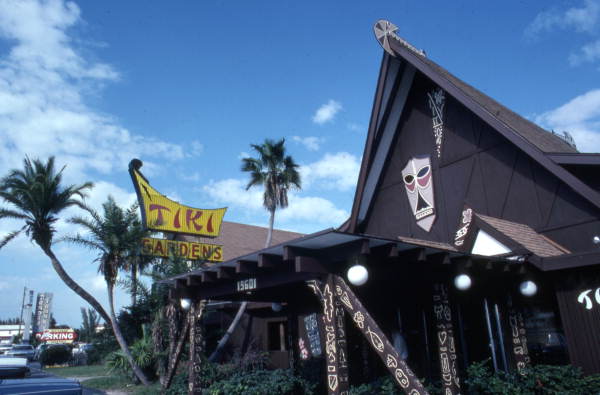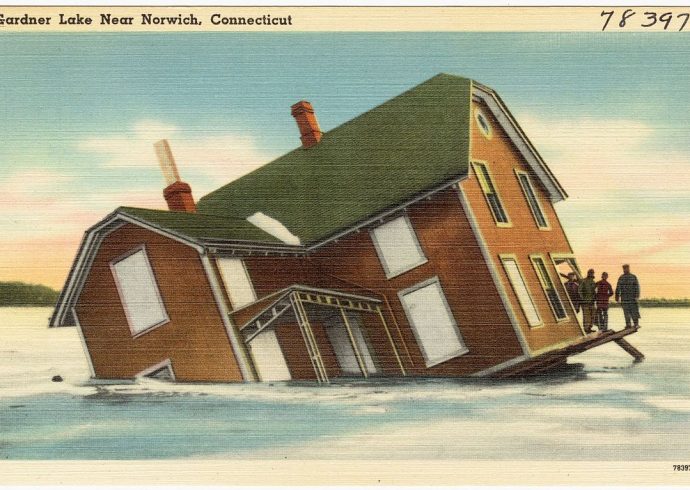
A bit of daytime reverie of being on a remote tropical island in the South Pacific surrounded by lush orchids and palm trees may interrupt a busy day of routine. Back in 1964, such a reverie was made reality when Tiki Gardens was officially opened in the town of Indian Shores located in Pinellas County, Florida.
The birth of Tiki Gardens dates all the way back to 1950 when Frank and Jo Byars opened a gift shop which sold seashell jewelry and remained in business until 1963 when it burned in a fire. One year later, near the same location as their gift shop on Gulf Boulevard in Indian Shores, the couple planned the unique Polynesian-inspired roadside attraction, opening to the public during the early part of summer in 1964. While the 1950’s to 1970’s were considered to be the height of tiki culture which embraced South Pacific art, whether it was Polynesian, Micronesian, or Melanesian, the history of tiki culture in the United States dates back to a man named Ernest Raymond Beaumont-Gantt. Beaumont-Gantt spent time in the South Pacific, eventually returning to California and opening a restaurant with a tiki theme in 1933. Soon interest in tiki art caught on and would eventually dominate in states like California and Florida. Subsequently, many tourist spots in Florida cashed in on the tiki culture, sometimes including only a single carved tiki in front of their establishment, to something full-blown like Mai Kai restaurant in Fort Lauderdale, built in 1956. The Mai Kai not only held luau-style entertainment but also has indoor and outdoor tiki garden areas for guests to appreciate.
Tiki Gardens was well planned from the start and added to every year. Monkeys and exotic birds were a major attraction, along with many tropical flowers like orchids as well as standard Florida plants and palm trees. Even a chapel was built on the grounds which became a popular spot for weddings. A lengthy, detailed article about Tiki Gardens appeared in Bradenton Herald dated September 4, 1970 describing the different gift shops on the property and what they sold. Needless to say, there was something for everyone, whether it was a piece of coral jewelry or a woven basket from South America. Tiki lights and tableware were sold in another shop for those planning a Saturday night luau beneath Florida’s full moon. Everything from coloring books, postcards, costume jewelry, volcanic rock, crystals, seashells, seashell jewelry could be purchased at Tiki Gardens. Even a special cologne was made for Tiki Gardens and sold exclusively on the property.
By 1987, Byars had ten different gift shops open at Tiki Gardens, in addition to Trader Frank’s restaurant which served South Pacific and Asian cuisine. A hiking trail decorated with grass huts, Polynesian tiki gods, and exotic flowers on both sides was adventurous to traverse. Live peacocks roamed freely and soon became a primary reason for tourists to stop by and spend an hour or two at Tiki Gardens. Native Tapa art appeared alongside more tikis, palms and orchid plants in Trader Frank’s. In addition to hiking the grounds, boat rides were also offered to visitors. A sun temple and a foot bridge across a pond provided a view of giant carved tiki gods like Lono, Kahuna, and Ku. Tikis that large might be found by a stranger sailing to a remote island in the South Pacific – or by one reading Armstrong Sperry’s Newbery Award winning book “Call It Courage”, a story about a Polynesian boy. First published in 1940 and still in circulation, “Call It Courage” was the young readers introduction to Polynesian life and culture for many years. To the child whose parents were planning a trip to Florida – and for decades it was the standard practice for families across the United States to visit Florida at least once a year for a vacation – and learned that Tiki Gardens was on the itinerary, making the annual trip something to look forward to. By 1987, Tiki Gardens had a half a million visitors per year since it first opened.
Like many a successful business dream, sadly, Tiki Gardens came to an end in the late 1980’s. According to an article in Tampa Bay Times, April 30, 1988, Byers sold Tiki Gardens to two Australian inventors, Neville Schmidt and Darrell Roder, to restore it to its former glory after a hurricane back in 1985 took down the electrical system in the garden area. The grounds also needed considerable maintenance done, which was considered to be very expensive. By 1990, Pinellas County bought Tiki Gardens for $3 million and tore down the remaining structures to build a public-access beach parking lot. A roadside sign indicates the location where Tiki Gardens once stood.
Image Credit: Florida. – Division of Tourism, February 1982.


